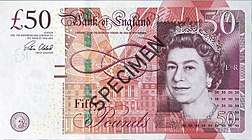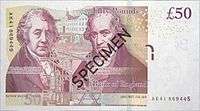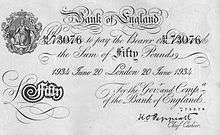Bank of England £50 note
| (United Kingdom) | |
|---|---|
| Value | £50 |
| Width | 156 mm |
| Height | 85 mm |
| Security features | Motion thread, raised print, metallic thread, watermark, microlettering, UV feature, see-through registration device |
| Paper type | Cotton |
| Years of printing |
1725–1943; 1981–1994; 1994–2011; 2011–present (current design) |
| Obverse | |
 | |
| Design | Queen Elizabeth II |
| Design date | 2 November 2011 |
| Reverse | |
 | |
| Design | Matthew Boulton and James Watt |
| Design date | 2 November 2011 |
The Bank of England £50 note is a banknote of the pound sterling. It is the highest denomination of banknote issued for public circulation by the Bank of England.[note 1] The current cotton note, first issued in 2011, bears the image of Queen Elizabeth II on the obverse and the images of engineer and scientist James Watt and industrialist and entrepreneur Matthew Boulton on the reverse.
History
Fifty pound notes were introduced by the Bank of England for the first time in 1725. The earliest notes were handwritten and were issued as needed to individuals. These notes were written on one side only and bore the name of the payee, the date, and the signature of the issuing cashier. With the exception of the Restriction Period between 1797 and 1821, when the French Revolutionary Wars and the Napoleonic Wars caused a bullion shortage, these notes could be exchanged in full, or in part, for an equivalent amount of gold when presented at the bank. If redeemed in part, the banknote would be signed to indicate the amount that had been redeemed. From 1853 printed notes replaced handwritten notes, with the declaration "I promise to pay the bearer on demand the sum of fifty pounds" replacing the name of the payee. This declaration remains on Bank of England banknotes to this day. A printed signature of one of three cashiers appeared on the printed notes, although this was replaced by the signature of the Chief Cashier from 1870 onward.[1]

The ability to redeem banknotes for gold ceased in 1931 when Britain stopped using the gold standard.[1] The £50 note ceased to be produced by the Bank of England in 1943 and did not reappear until it was reintroduced in 1981. These D series notes were predominantly olive green on both sides, with an image of Queen Elizabeth II on the front (as with all subsequent £50 notes) and an image of architect Christopher Wren on the back. As a security feature, this note had a metallic thread running through it, which was upgraded to a "windowed" thread from July 1988 onward. The thread is woven into the paper such that it forms a dashed line, yet appears as a single line when held up to the light. The series D note was gradually replaced by the series E, beginning in 1994. This reddish note replaced Christopher Wren with John Houblon, the first governor of the Bank of England, on the reverse. As an additional security feature, these notes had a foil patch on the front.[2]
The current £50 note was introduced in 2011. It features two portraits on the reverse: engineer and scientist James Watt and industrialist and entrepreneur Matthew Boulton, along with the Whitbread Engine and the Soho Manufactory, Birmingham.[3][4] The note has a number of security features in addition to the metallic thread, including motion thread, raised print, a watermark, microlettering, a see-through register, and a colourful pattern that only appears under ultraviolet light.[5] The current note is the first Bank of England banknote to feature two people on the reverse,[6] and the first Bank of England note to feature the motion thread security feature. This is an image in a broken green thread that moves as the note is viewed from different angles.
Future
The Bank of England has issued new £5, £10 and £20 notes in polymer form.[7] The Governor of the Bank of England, Mark Carney has said there are "no plans" for a polymer £50.[8]
Peter Sands, an advisor to the British Government and former Chief Executive of Standard Chartered, has raised concern with the Bank of England over high denomination notes and their role in tax evasion. He claimed that scrapping the £50, and other high denomination notes such as the CHF 1000 and $100, will reduce financial crime.[9][10]
However, a Bank of England source told the Financial Times (FT) in December 2016 that there were no plans to remove the note from circulation. The FT said the removal would be "a loss of Liberty" and raised points that the £50 is useful for high-value cash transactions, such as eating out.[11]
Furthermore, there is a worldwide precedent for mixed material currency as the Singapore Dollar has its 2, 5, and 10 dollar bills on polymer substrate and their 50, 100, 1000, and 10,000 dollar bills on paper.
In October 2018, the Bank of England announced that the £50 note would be retained and given a polymer redesign. [12]
Designs
| Note | First issued | Last issued | Ceased to be legal tender | Colour | Size | Design | Additional information |
|---|---|---|---|---|---|---|---|
| White | 1725 | 1943 | 16 April 1945 | Monochrome (printed on one side only) | 211 × 133 mm (may vary) | ||
| Series D | 20 March 1981 | 1994 | 20 September 1996 | Predominantly olive green | 169 × 95 mm | Front: Queen Elizabeth II; Back: Christopher Wren | First £50 note to carry a portrait of a monarch and used a 'windowed' security thread (July 1988 onwards) |
| Series E | 20 April 1994 | 2011 | 30 April 2014 | Predominantly red | 156 × 85 mm | Front: Queen Elizabeth II; Back: John Houblon | Foil patch for additional security |
| Series F | 2 November 2011 | Predominantly red | 156 × 85 mm | Front: Queen Elizabeth II; Back: Matthew Boulton and James Watt | |||
See also
Notes
- ↑ The Bank of England issues plain notes in the values of £1 million and £100 million for internal use.
References
- 1 2 3 "A brief history of banknotes". Bank of England. Retrieved 28 April 2016.
- 1 2 "Withdrawn banknotes reference guide" (PDF). Bank of England. Retrieved 28 April 2016.
- ↑ "Steam engine heroes grace new £50 banknote". Channel 4. 30 September 2011. Retrieved 13 March 2015.
- ↑ "£50 Note – Design Features". Bank of England. Retrieved 28 April 2016.
- ↑ "£50 Note – Security Features". Bank of England. Retrieved 28 April 2016.
- ↑ "New £50 banknote in circulation". BBC News. Retrieved 28 April 2016.
- ↑ Peachey, Kevin (2015-09-02). "Paper banknotes disappearing fast as £20 turns plastic". BBC News. Retrieved 2017-01-06.
- ↑ "Reports state that the £50 note will remain circulation after a Bank of England statement "Following HM Treasury's announcement, the Bank can confirm that it plans to issue a new £50 note"". The Telegraph. Retrieved 2017-01-06.
- ↑ "Ban £50 notes to tackle crime, ex-bank chief says". BBC News. 8 February 2016. Retrieved 6 January 2017.
- ↑ Wilkinson, Michael (8 February 2016). "Scrap £50 notes to stop plumbers and builders avoiding tax, urges government adviser". The Daily Telegraph. Retrieved 6 January 2017.
- ↑ Stott, Michael (15 December 2016). "An Unloved Banknote - Is the £50 in Danger?". Financial Times. Retrieved 6 January 2017.
- ↑ https://www.bbc.co.uk/news/uk-45850135